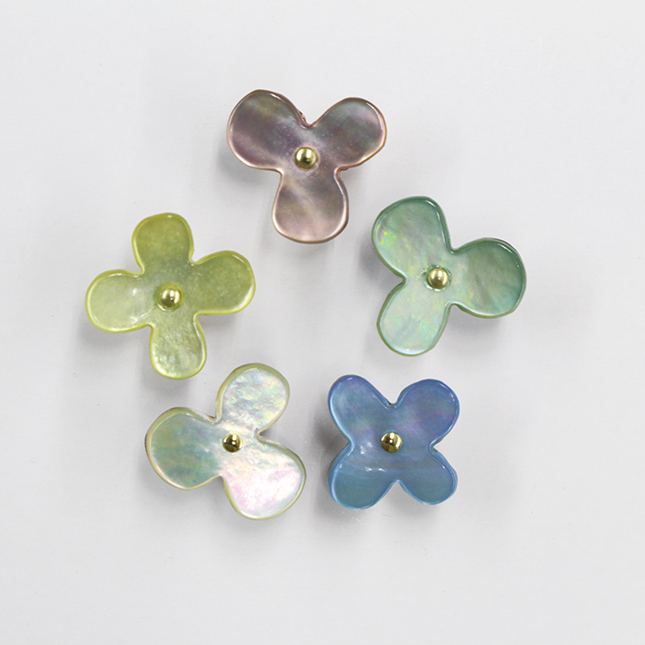TOMOI Co., LTD. / Flower Push Pin (Mother-of-Pearl)
Story to show Japanese craftsmanship through the things, the place and the people related to Cohana’s products. Our fifth story is Flower Push Pin (Mother-of-Pearl) by TOMOI Co., LTD.
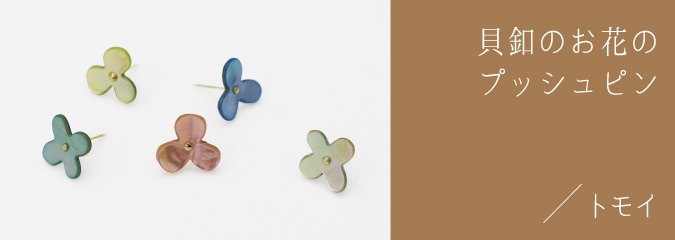
Shell buttons add a delicate luster and smooth touch to the supple fabric of men’s clothing and high-end shirts. Although it is a small part, it has been valued as a fashionable item by people who appreciate fashion.
Surprisingly, the largest production area of shell buttons in Japan is Kawanishi-cho, Nara Prefecture, a town without a sea.
We visited Tomoi, which has been carrying the tradition of this button industry since its establishment in 1914. Kawanishi-cho, Nara Prefecture, located in the center of the Nara Basin, is a peaceful town surrounded by rice fields. However, if you take a short stroll around the town, you will find small pieces of shells everywhere, giving you a hint of the industry that the town has built.
A cute signboard of the company Tomoi.

We had this opportunity to interview with the president Hiroshi Tomoi.
ーHow did the shell button industry develop in Kawanishi Town, where there is no sea?
In Kawanishi Town, there are six rivers flowing, and they are connected to Osaka. The location was the great advantage for this area to be a center of accumulation and distribution for the boat transportation between Osaka and Nara. This local advantage led to the development of the shell button industry. Since there are many farmers in this area, the shell button station industry spread as a valuable source of income during the winter off-season. At its peak in the 1950s, about 300 of the 400 households in the town were involved in the shell button production.
ーSo the whole small town was a big shell button factory.
Yes, that’ s right. But now, the number of households involved in the shell button has decreased to about a dozen. Polyester buttons, which are inexpensive to produce, have taken over. In terms of distribution percentage, natural materials account for 10%, polyester 90%, and shell buttons only account for 5% of all natural materials.
ーUnder such circumstances, Tomoi’s share of the domestic shell button market is about 50%, and the product is highly evaluated by famous brands. The rise of inexpensive materials such as polyester, and the recent trend of fast fashion. You must have had a lot of rough times in the past, but is there anything that you cherish in your work?
It’s simple, but it’s to make high quality shell buttons. We are able to make use of the color and thickness of the material itself with our accumulated knowledge and experience while matching them to the design required by the customer. The connection with the people in this town is essential to maintain the quality of our products. There are “nukiya” who specializes in hollowing out the button fabric from the shell and “suriya” who specializes in adjusting the thickness working for us. A single button is made by the “baton” of craftsmen from hand to hand, and we value the cooperation and bond between them.
ーThank you very much. By the way, I heard that you went to Italy to study button technology. Did you find uniqueness of Japanese shell buttons compared to the authentic Italian button?

▲He opened a beautiful sample book and explained the process.
I believe that this radiating striated cutting is a uniquely Japanese design. It is a design that requires a lot of time and skill, because it cannot be rotated and cut all at once.
By the way, in terms of the demand for buttons in Japan, buttons with relatively large holes tend to be preferred. In Japan, sewers require buttons with large holels that can be easily sewn on with a sewing machine. However, in Italy, people demand for buttons with small holes. These buttons with small holes require hand sewing.
I felt that the fashion sense is created by this kind of attention to buttons.
ーI see. By the way, are there any trends in button station?
Yes, there are. You know there are differences between the bubble period and now. I think it’s important to learn about the trends from designers and apparel manufacturers.

While keeping abreast of current trends with a sense of style that he grasped in Italy, he also values his traditional ties with the community in which he works. In this interview, we could feel the sincere attitude of Mr. Tomoi toward his work.
After the interview, we went to the factory to see the process of general button manufacturing and Cohana’s shell button manufacturing.
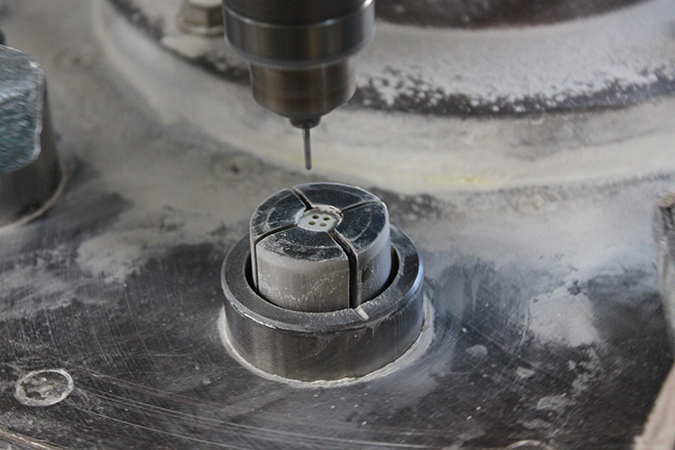
▲The process of drilling holes. A small drill rotates at high speed to efficiently drill clean holes.
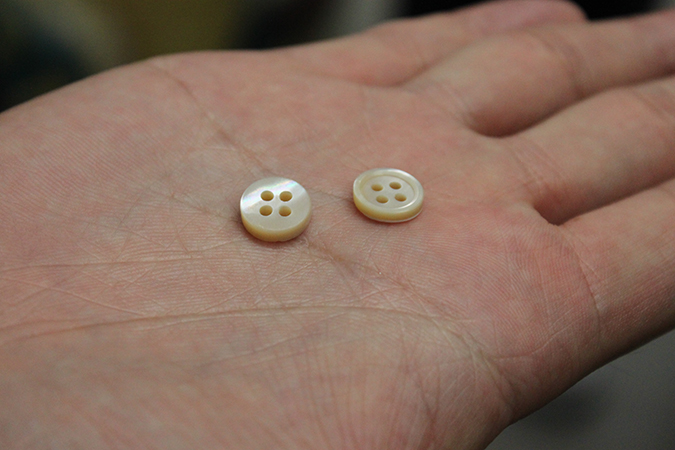
▲The ribs and stripes are shaved with a special blade while the button is spinning on the wheel.

The blade shape determines the subtle design of the buttons, so the blade shape is very important. We have installed a machine that can make the blade from scratch to meet various needs.

▲A sample book made with the various orders from the past showed us the high level of Tomoi’s skills, knowledge, and experience.
This is the shell of Akoya pearl will be used for Cohana’s Flower Push Pin.

▲The Akoya pearl shell shines beautifully.

▲A round chip taken from the Akoya pearl shell is put through the machine, and a flower-shaped piece is cut out in no time!
Cutting part is quick, but the process continues, Tomoi said.
These barrels, called “teppo,” are used in the process of polishing and refining the shells.
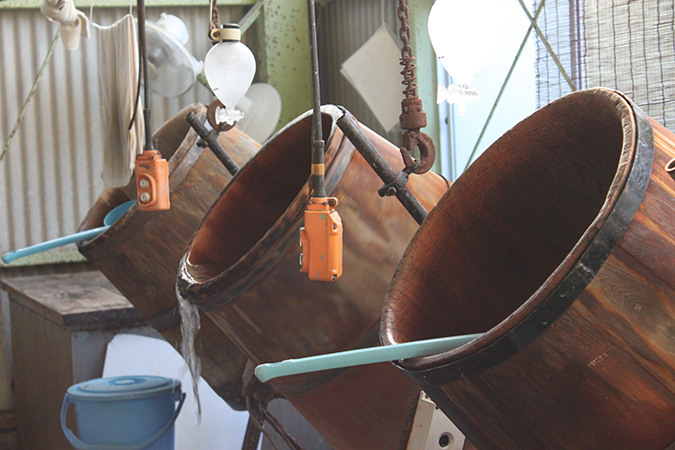
▲A small amount of hot water and special chemicals are added to these barrels, and they are rotated for about an hour. It is difficult to adjust the water temperature, and this is where the experience of the craftsmen is utilized.

In the next process, surprisingly rice husks are used!
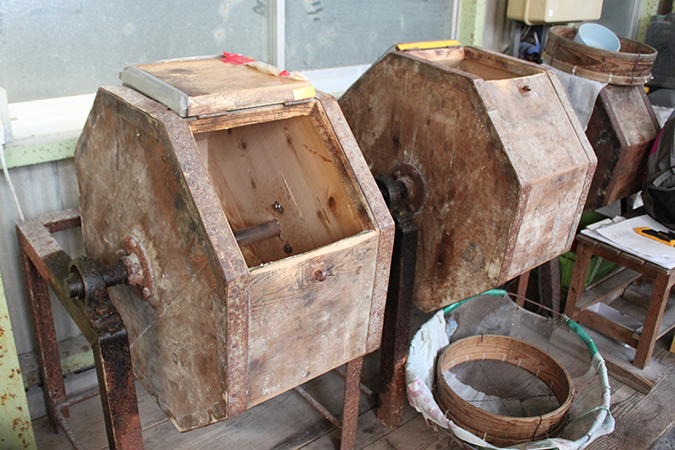
For the final polishing, wax and rice husks are used. When you put them into the different rotate barrels, the wax act as a rinse and the rice husks act as brush so they can give the shell pieces smooth touch. You can feel the differences between before and after if you check them.


With these pictures it is hard to convey how much shells get smoother than ones before this process. Before this process shell pieces have rough touch, but after this final polishing they are smooth and sleek to the touch.
As for last to see, we went to a brightly lit room.

▲Each piece is inspected by eye. The mother of the current president accurately checks the appearance of the shell pieces, and picks faulty ones.

▲Quietly, earnestly, and silently. Because shells are natural materials that have lived in a variety of environments, it is natural for them to have small scratches and dull colors. However, as a product, it cannot be ignored.
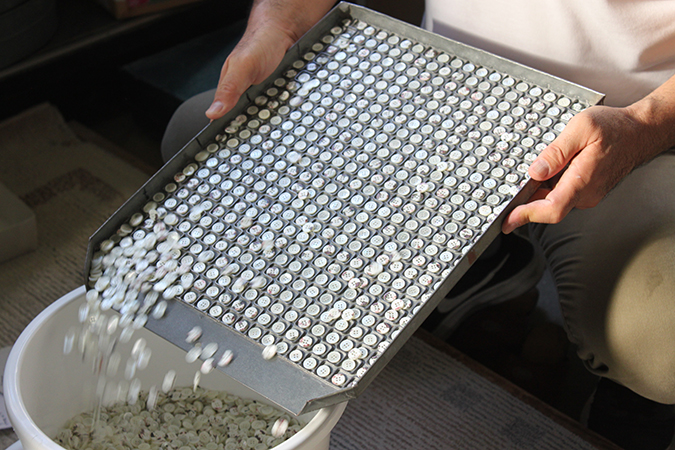
▲After counting the number of shells with a special device, they are ready to be shipped. This operation is not easy for amateurs.
A lot of processes and the experience of the craftsmen are packed into a small shell button.
For the pleasure of customers, they carefully protect and maintain their excellent skills and keep up with the current trends.
I felt that there are many things we can learn from their attitude toward their products.
I gently wrapped the Cohana shell buttons I received with soft cloth carefully and left the factory.
TOMOI Co., LTD.
Kawanishi Town, Nara Prefecture is the largest producer of shellfish buttons in Japan, even though it is a land without the sea. The six rivers that flow through the town brought boat transportations from Osaka, and shell button manufacture became an important source of income for people in this town especially during the agriculture off-seasons. Tomoi was founded here in 1913. Their technology, acquired through years of experience in the manufacturing of shell buttons, has won the trust of the global fashion industry.
